The Declining Empire of Chaos Is Going Nuts Over Iran
by Federico Pieraccini, Strategic Culture:

The transition in recent years from a unipolar to a multipolar world order has created international tensions that seem to threaten to escalate into clashes between regional and global powers.
In 2014 we were almost at the point of no return in Ukraine following the coup d’etat supported and funded by NATO and involving extremist right-wing Ukrainian nationalists. The conflict in the Donbass risked escalating into a conflict between NATO and the Russian Federation, every day in the summer and autumn of 2014 threatening to be doomsday. Rather than respond to the understandable impulse to send Russian troops into Ukraine to defend the population of Donbass, Putin had the presense of mind to pursue the less direct and more sensible strategy of supporting the material capacity of the residents of Donbass to resist the depredations of the Ukrainian army and their neo-Nazi Banderite thugs. Meanwhile, Europe’s inept leaders initially egged on Ukraine’s destabilization, only to get cold feet after reflecting on the possibility of having a conflict between Moscow and Washington fought on European soil.
With the resistance in Donbass managing to successfully hold back Ukrainian assaults, the conflict began to freeze, almost to the point of a complete ceasefire, even as Ukrainian provocations continue to this day.
Tensions were then focussed on Syria, where a mercenary army of at least 200,000 men, armed and trained by the US, UK, Israel, France, Turkey, Jordan, Saudi Arabia, Qatar and the United Arab Emirates, almost managed to completely topple the country. Russian intervention in 2015 managed to save the country with no time to spare, destroying large numbers of terrorists and reorganizing the Syrian armed forces and training and equipping them with the necessary means to beat back the jihadi waves. The Russians also ensured control of the skies through their network of Pantsir-S1, Pantsir-S2, S-300 and S-400 air-defence systems, together with their impressivejamming (Krasukha-4), command and control information management system (Strelets C4ISR System) and electronic-warfare technologies (1RL257 Krasukha-4).
As the Americans, British, French and Israelis conducted their bombing missions in Syria, the danger of a deliberate attack on Russian positions always remained, something that would have had devastating consequences for the region and beyond. It is no secret that US military planners have repeatedly argued for a direct conflict with Moscow in a contained regional theater. (Clinton called for the downing of Russian jets over Syria, and former US officials claimed that some Russians had to “pay a little price”.)
Since Trump became president, the rhetoric of war has soared considerably, even as the awareness remains that any new conflict would sink Trump’s chances of re-election. Despite this, Trump’s bombings in Syria were real and potentially very harmful to the Syrian state. Nevertheless, they were foiled by Russia’s electronic-warfare capability, which was able to send veering away from their intended target more than 70% of the latest-generation missiles launched by the British, French, Americans and Israelis.
One of the most terrifying moments for the future of humanity came a few months later when Trump started hurling threats and abuses at Kim Jong-un, threatening to reduce Pyongyang to ashes. Trump, moreover, delivered his fiery threats in a speech at the United Nations General Assembly.
Trump’s dramatic U-turn following his historic meeting with Kim Jong-un (a public relations/photo opportunity) began to paint a fairly comical and unreliable picture of US power, revealing to the world the new US president’s strategy. The president threatens to nuke a country, but only as a negotiating tactic to bring his opponent to the negotiating table and thereby clinch a deal. He then presents himself to his domestic audience as the “great” deal-maker.
With Iran, the recent target of the US administration, the bargaining method is the same, though with decidedly different results. In the cases of Ukraine and North Korea, the two most powerful lobbies in Washington, the Israeli and Saudi lobbies, have had little to say. Of course the neocons and the arms lobbyists are always gunning for war, but these two powerful state-backed lobbies were notably silent with regard to these countries, less towards Syria obviously. As distinguished political scientist John J. Mearsheimer has repeatedly explained, the Israel and Saudi lobbies have unlimited funds for corrupting Democrats and Republicans in order to push their foreign-policy goals.
The difference between the case of Iran and the aforementioned cases of Ukraine, Syria and North Korea is precisely the direct involvement of these two lobbies in the decision-making process underway in the US.
These two lobbies (together with their neocon allies) have for years been pushing to have a few hundred thousand young Americans sent to Iran to sacrifice themselves for the purposes of destroying Iran and her people. Such geopolitical games are played at the cost of US taxpayers, the lives of their children sent to war, and the lives of the people of the Middle East, who have been devastated by decades of conflict.
Read More @ Strategic-Culture.org
Loading...



